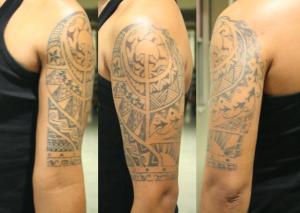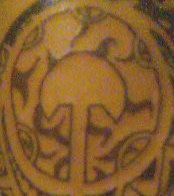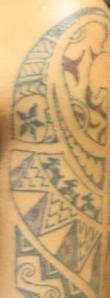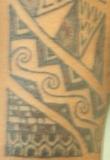Kayumanggi at Ipinagmamalaki! (Brown and Proud of it!)
It has been almost 3 years since I got my first tattoo. That is my (nick)name spelled across my back (below my nape) in what is known as the baybayin (the proper name) or widely recognized as the alibata. I chose to use the said writing method because of one primary reason – it’s Filipino.

Just last February 23, 2008, I got my left arm tattooed with a half-sleeve story of my roots and lineage. The symbols I used in it are strongly influenced by the designs used by the highlanders of the north. Polynesian designs or symbols would have been okay. In fact they’re cool. Thing is, I am not of Polynesian blood. My tattoos are a strong declaration of my Pinoy Pride. I am brown and I am proud of it!

AnakAmaGuro
One famous tattooed celebrity is Dwayne “The Rock” Johnson. His ink tells a story – and it’s very interesting.
No, I have no fantasies of becoming famous, nor becoming a wrestler! I just want to tell my story through this very interesting art form, where skin is canvass and ink is paint.
My sleeve tattoo tells the story of my immediate roots. It is a celebration of my heritage and my bloodline.
•The “ling-ling-o” (Mamuli)

The figure symbolizes “celebration of life” – the ability of man and woman to procreate life with Bathala (God).
This portion of my tattoo has 5 slots, one for each child born to my family.
Historical notes:
The ling-ling-o is an amulet found throughout the Philippines and Southeast Asia both in modern and ancient times.The exact meaning of the ling-ling-o is a matter of debate.Various explanations are brought forth including use as good luck and/or fertility charm or as a partial residence for anitos (ancestral spirits).Among the Igorots, the amulet is empowered / purified in a ritual of washing in blood before wearing.
The open oval shape of the mamuli is similar to the female reproductive organ. The mamuli is known as a symbol of fertility, combining both masculine and feminine attributes. By wearing one it symbolizes virility (men) and fertility (women).
? My Mother’s side

• The Healer’s seal
The pointed figure with the star on the upper left side of the photo is symbol of a healer. I incorporated it in the design to honor my late grandfather. He had knowledge of medicinal plants and was a recognized Albularyo (medicine man) in his town.
• The Water Buffalo’s (Carabao) Horn.
A symbol of protection against the evil eye.
Power, purification, healing, wisdom, self-knowledge, renewal and eternal life.
Other superstitions link it to sexual power and good luck.
• The Carabao
A totem symbol of strength, loyalty and humility but also danger, when provoked.
• Mountains
My mother’s family are from the highlands – thus, the mountains.
• The Rice Fields
Staple to Filipinos is rice. Source of nourishment and of life. Rice Grains when full and ripe bow. Looking back to the earth that nourished it. It symbolizes humility, gratitude and strength.
Being that they are farmers from the highlands, the theme incorporated the brief story of my maternal bloodline.
? My Father’s side

• Fish
This was the primary source of income for the small fishing village where my father hails from.
Fish symbolize unity, and strength. They are never alone, always swimming in schools.
There are seven of them here. One for each member of the family.
•Corals
They represent home.
Be it that I am far and away from home, I will always long to come back to the one place where I feel safe.
•Weave
My father is also a tailor. Thread when woven becomes a strong material. Cloth when put together and sewn, provides warmth and protection.
•Earth and Water and the countless generation of Fathers and Fishermen
My father and his father, and his father’s father, and all the generations before him were fishermen. During seasons when the men of our village could not cast their nets into the deeps to fish, they turn to the richness of the earth that nourishes their crops. They plant corn, and grain and root crops that sustain them during these times.
The Triangles that are connected to the mountains and the sea by a thin line represent the generations that came before me. I pay tribute to them. This is my way of saying, “I will not forget”.
?The Fire Snake

One of the oldest symbols in existence, the snake’s image is found long before the written word appeared.
As a tattoo design, the snake symbolizes power, both natural and supernatural, fertility, regeneration and wisdom.
The snake’s ability to slough off its skin is truly fascinating. This has given rise to its association with rebirth and immortality.
I was born in the year of the snake, under the fire sign.
The 5 triangles represent each child in the brood. The repeating triangle patterns signify strength – strength in the family. They point downwards to honor our mother – the bringer of life.
The four swirls represent my sisters – one swirl for each sister. Spirals or swirls are linked to the circle (symbol). It is an ancient symbol of the goddess, the womb, fertility, feminine serpent force, continual change and the evolution of the universe.
The 3 dotted black triangles represent each decade of my life.
Triangles are associated with the number 3 (three). They point upwards to symbolize fire, male, and power. Again, the pattern is repeated to strengthen the symbol.
?The Sun
Fire is my element. Fire is probably one of man’s greatest discoveries.
A symbol for “the bringer of light”; illuminates the path of those who travel. Showing them the right road and direction, guiding them towards their destination.
? The Stones of power and the Shield

Black and white, Light and dark, the unity of opposites – they represent the duality in all things; even in man. They represent choice and decisions to be made.
In my life, I have made good and not so good choices. Good and bad decisions. They serve as a reminder that I have the power to change everything in the future with the choices I make today.
The shield is a talisman of protection. To ward off evil and in turn, invite positive energy.
?My Son

Angelo
I chose this symbol to represent my son.
?Anak (in baybayin)
Son

Anak
?Ama (in baybayin)
Father

Ama
?Guro (in baybayin)
Teacher

Guro
The tattoo is still not done… I’d still have to have it retouched.
I have plans of extending it to my left shoulder blade, shoulder and left chest area – more of that soon.














